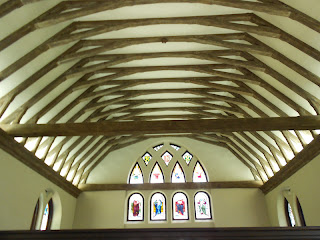In Walden, Henry David Thoreau observes that
"you only need sit still long enough
in some attractive spot in the woods
that all its inhabitants may exhibit themselves to you by turns."
In my experience, this can happen
even when one just goes out of doors.
This week my husband and I have sighted several wild animals
"you only need sit still long enough
in some attractive spot in the woods
that all its inhabitants may exhibit themselves to you by turns."
In my experience, this can happen
even when one just goes out of doors.
This week my husband and I have sighted several wild animals
going about their day-to-day lives
as we have been going about ours.
as we have been going about ours.
That chance intersection between human and beast
always seems to me an exciting and noteworthy event.
Somehow, it makes the day special and reassures
that we are not apart from the natural world.
It provides the "tonic of wildness" as Thoreau once put it.
always seems to me an exciting and noteworthy event.
Somehow, it makes the day special and reassures
that we are not apart from the natural world.
It provides the "tonic of wildness" as Thoreau once put it.
So here are a couple of our creature encounters this week:
One of our neighbors has a crab apple tree that is full of fruit.
The last time it bore fruit, raccoons made it a regular stop
on their nightly forages.
I know this because while walking my dogs one night,
a large raccoon and I startled one another.
Its eyes shone in the darkness for a brief second,
but long enough to render me
more or less rooted in one spot,
giving said raccoon time to run for the woods.
Now this week a gray squirrel visited the same tree
Its eyes shone in the darkness for a brief second,
but long enough to render me
more or less rooted in one spot,
giving said raccoon time to run for the woods.
Now this week a gray squirrel visited the same tree
and carried off a plump golden crab apple in its mouth.
I'm not exaggerating when I say the apple
was larger than the squirrel's head,
but there was no way he would relinquish it.
but there was no way he would relinquish it.
I tried to get a photo, but the squirrel,
certain I was after his food and not his image,
ran partly up a tree and then down the other side
and confounded my efforts.
Here's a recent photo of a gray squirrel
who is preparing to jump from the railing:

and confounded my efforts.
Here's a recent photo of a gray squirrel
who is preparing to jump from the railing:

Then another evening while we were in the yard,
a small rabbit came into view in our woods.
I always like seeing rabbits here in the Shire.
They move so quickly and have the cutest white cotton tails.
But generally they are too fast for me to photograph.
Here's an image I was able to capture a few weeks ago:
Tomorrow, more animals who exhibited themselves "by turns."
<>
But generally they are too fast for me to photograph.
Here's an image I was able to capture a few weeks ago:
Tomorrow, more animals who exhibited themselves "by turns."
<>
















































